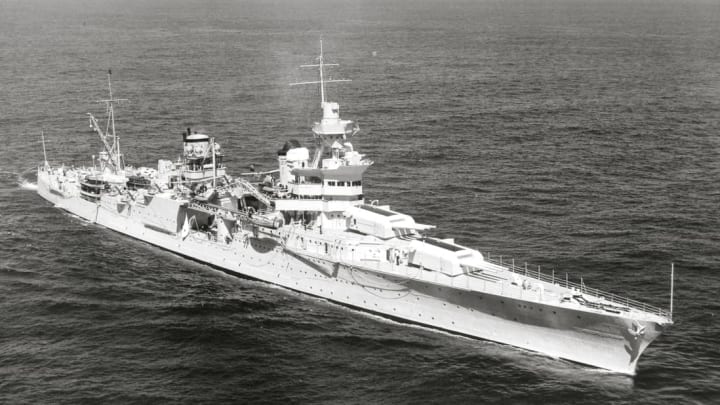Civilian Researchers Discover Wreckage of the USS Indianapolis

On July 30, 1945, the cruiser USS Indianapolis sank in the Pacific Ocean after it was torpedoed by the Imperial Japanese Navy submarine I-58. More than 70 years after the historic naval tragedy— which claimed the lives of nearly 900 crew—The New York Times reports that the ship’s mysterious final resting place has been found.
The discovery came courtesy of a team of civilian researchers, led by Microsoft co-founder Paul Allen. His state-of-the-art research vessel, Petrel, located the wreck 18,000 feet below the Pacific’s surface, the team announced on Saturday, August 19.
"To be able to honor the brave men of the USS Indianapolis and their families through the discovery of a ship that played such a significant role in ending World War II is truly humbling,” Allen said in a statement. “As Americans, we all owe a debt of gratitude to the crew for their courage, persistence, and sacrifice in the face of horrendous circumstances."
Before it sank, the USS Indianapolis had just completed a top-secret mission to a naval base on the Northern Mariana island of Tinian. After delivering enriched uranium and components for Little Boy— the atomic bomb that the U.S. would drop on the Japanese city of Hiroshima about a week later—the cruiser forged ahead to Guam, and then to the Philippines. It was supposed to meet the battleship USS Idaho at Leyte Gulf in the Philippines to prepare to attack Japan.
The USS Indianapolis never made it to Leyte Gulf. Shortly after midnight on July 30, the Japanese submarine I-58 spotted the cruiser and fired six torpedoes. The USS Indianapolis—which was hit twice—sank within 12 minutes. Around 300 to 400 sailors and Marines were killed in the attack; the rest were stranded in the Pacific Ocean for several days.
Many of these survivors would ultimately lose their lives to sharks, a grisly scene that would be famously (albeit semi-accurately) recounted in the 1975 movie Jaws. Others died from drowning, heat stroke, thirst, burns and injuries, swallowing salt water or fuel oil, and suicide. More than 300 crew members were rescued after a bomber pilot accidently sighted the imperiled men while on a routine antisubmarine patrol.
The mass tragedy—which wouldn’t be announced to the public until August 15, 1945—sparked controversy: Charles B. McVay III, captain of the USS Indianapolis, was found guilty in a court martial of failing to steer the ship on a “zigzag” course to elude Japanese submarines. A Japanese submarine captain testified that this precautionary measure wouldn’t have thwarted the enemy, but McVay was charged nonetheless. The captain died by suicide in 1968, and wouldn’t be officially exonerated by the Navy until 2001.
For decades, the remains of the USS Indianapolis were lost to the ravages of time and nature. But in 2016, naval historian Richard Hulver found a historic ship log that mentioned a sighting of the USS Indianapolis. Allen’s search team used this information to locate the ship, which was west of where experts assumed it had gone down.
Allen’s crew took pictures of the wreckage, including a piece of its hull, and will search for more of the ship. They plan to keep the exact location of the USS Indianapolis a secret, however, to honor the sunken ship as a war grave.
"While our search for the rest of the wreckage will continue, I hope everyone connected to this historic ship will feel some measure of closure at this discovery so long in coming,” Allen said.
[h/t The New York Times]